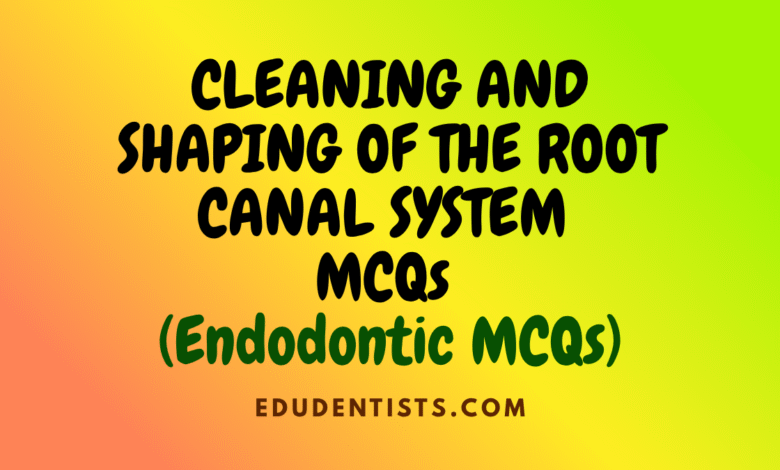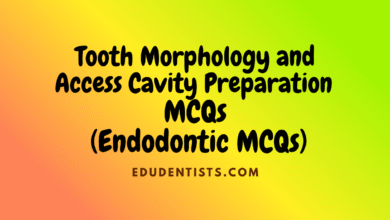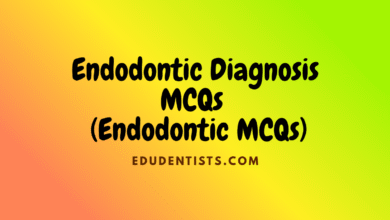CLEANING AND SHAPING OF THE ROOT CANAL SYSTEM (Endodontics MCQs)
CLEANING AND SHAPING OF THE ROOT CANAL SYSTEM _ Endodontics MCQs

CLEANING AND SHAPING OF THE ROOT CANAL SYSTEM _ Endodontics MCQs
CLEANING AND SHAPING OF THE ROOT CANAL SYSTEM _ Endodontics MCQs
1. All of the following are objectives of cleaning and shaping except one. Which is the exception:
A) Remove infected soft and hard tissue.
B) Allow access of disinfecting irrigants to apical canal space
C) Create space for medicament delivery and subsequent obturation
D) Retain the integrity of radicular structures
E) Maintain the initial apical canal diameter
2. Which of the following statements best describes Batt tips:
A) They are the sharp, angulated barbs found on broaches.
B) They have a sharp transition angle, which makes negotiation around curves difficult.
C) The term describes the noncutting tip on burs used in endodontic access preparations.
D) They have a smooth transition angle and are noncutting.
3. Which of the following statements about ISO standardized files is correct:
A) D0 is the cross-sectional diameter at the first rake angle.
B) The rake angle is set at 45 degrees.
C) The diameter of a size 25 file at D16 is 0.41mm.
D) D1 is the cross-sectional diameter at the instrument tip.
E) The greatest magnitude of change in tip diameter occurs in the transition from a size 55 file to a size 60 file.
4. Which of the following statements best describe LightSpeed instruments:
A) The cross-sectional diameter of the instruments increases by a constant 29.
B) The instrument shaft increases by 0.02mm per millimeter.
C) Cross sections through the cutting portion of the shaft reveal three U-shaped depressions.
D) The instruments require maximal torque at slow speeds because of the flute design.
5. All of the following statements about GT-files are correct except one. Which is the exception:
A) The maximal diameter of the accessory file shaft is 1.5mm.
B) The accessory series of instruments have distinct tapers four tapers with tip diameters of 35, 50, and 70.
C) Radial lands and a central parallel core are evident on cross sections.
D) The standard set of instruments includes four distinct tapers and tip diameters equivalent to sizes 20, 30, and 40 ISO files.
E) The flutes have a variable pitch.
6. A positive rake angle is associated with which of the following instruments:
A) HERO 642
B) ProFile Series 29
C) LightSpeed
D) ProFile
E) GT-files
7. Finishing files in the ProTaper series:
A) Have partially active cutting tips with diameters of 0.185 and 0.2mm
B) Have tapers of 0.07, 0.08, and 0.09 between D0 and D3
C) Are rectangular in cross section and have a constant helix angle
D) Should be used at 1000 to 1500rpm
E) Have radial lands that keep the instrument centered
8. Which statement best describes the physical and chemical properties of nickel-titanium instruments:
A) When stressed, the metal has an austenitic crystalline structure.
B) The instruments corrode when exposed to sodium hypochlorite.
C) The percentage of titanium by weight exceeds the percentage of nickel.
D) The instruments transition from a austenitic crystalline structure to a martensitic structure when stressed.
9. A crown-down approach to instrumentation with rotary nickel-titanium files:
A) Has been advocated to reduce the area of surface contact and friction
B) Reduces flexural fatigue
C) Requires apical application of force similar to that required to place amalgam
D) Requires the use of instruments with varying tapers and a constant tip diameter
E) Is best accomplished with instruments that have a consistent taper and variable tip diameter
10. The use of electric motors in rotary nickel-titanium preparations:
A) Reduces the risk of fracture caused by cyclic fatigue but not that caused by torsional fatigue
B) Produces a constant rpm that is less than the torque required for instrument fracture
C) Are manufactured with torque control that prevents instrument fracture due to cyclic fatigue
D) Allows the use of variable rpm settings and torque adjustments
11. The use of chlorhexidine as an endodontic irrigant:
A) May be advantageous because of its ability to bind to hydroxyapatite and possible sustained antimicrobial activity
B) Is advocated because of its ability to inhibit cellular division
C) Is not indicated when calcium hydroxide is to be used because of pulp necrosis and chronic apical periodontitis
D) Is contraindicated because of its narrow spectrum of activity and possible resistance
12. Achieving apical patency in endodontic treatment is best described as:
A) Placing a small file through the apical foramen before beginning the canal cleaning and shaping procedures.
B) Placing a small file to the corrected working length after the use of each instrument to prevent packing of debris and loss of length.
C) Placing a small file through the apical foramen after the use of each instrument.
D) Placing a small file to working length, followed by successively larger files until binding occurs.
13. All of the following statements about the use of sodium hypochlorite as an endodontic irrigant are correct except one. Which is the exception:
A) Heating the solution can enhance the antimicrobial action but does not affect the solvent capabilities.
B) In higher concentrations (5.25) it can dissolve both vital and necrotic tissues.
C) Free chlorine breaks down proteins into amino acids.
D) The irrigating solution serves as a lubricant and mechanically removes debris.
E) Heating the solution may have severe detrimental effects on nickel-titanium instruments.
14. Apical patency is maintained for all of the following reasons except one. Which is the exception:
A) To preserve the apical anatomy
B) To enhance the flushing action of the irrigant
C) To loosen debris
D) To maintain obturating materials in the root
15. Root canals should be cleaned, shaped, and obturated to the constricture for all of the following reasons except one. Which is the exception:
A) The constriction is the narrowest diameter of the canal.
B) Lateral and accessory canals are common in the apical 1 to 2mm of the canal.
C) The clinician can easily identify the constriction.
D) Obturating materials are maintained within the root canal system.
16. The balanced force technique is best described by which of the following statements:
A) The file is passively placed to the point of first binding and then rotated one to two turns in a counterclockwise direction.
B) Dentin is engaged with the file rotating in a clockwise direction for a quarter turn, followed by a counterclockwise rotation with inward pressure for at least one third of a revolut ion.
C) The file is oscillated back and forth 30 to 60 degrees as it is positioned apically, followed by a clockwise rotation of 180 degrees before removal.
D) The file is placed passively to a point of first binding and then rotated in clockwise at least 180 degrees using apical pressure, followed by a counterclockwise rotation to evacuate debris.
17. All of the following are components of recapitulation except one.
Which is the exception:
A) Loosening of debris and tissue in the apical portion of the canal, which could produce blockage
B) Reintroduction of files previously used in cleaning and shaping procedures
C) Irrigation with sodium hypochlorite
D) Sterilization and disinfection of the radicular space
18. Which of the following is most often responsible for short, underfilled canals:
A) Severe curvatures.
B) Packing of debris.
C) Canal ledging.
D) Calcification of the canal.
19. RC-Prep and Glyoxide
A) Have lubricating properties.
B) Are used during the later stages of shaping of the canal to reduce ledge formation.
C) Prevent formation of the smear layer during canal preparation.
D) Digest collagenous components of the root canal system.





